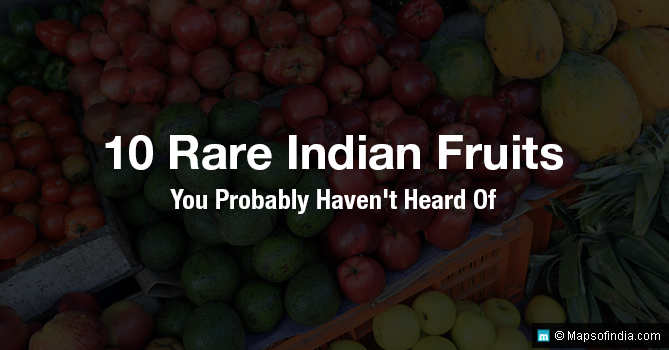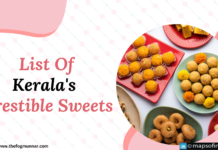There are some fruits which are not very popular and are mostly grown in tropical regions. These fruits are not commonly consumed in every region. You might not have known their health benefits before.
Fruits are an integral part of the human diet and contribute towards nutrition, as they are rich sources of fibre, vitamin C and water. India, with the most diverse climatic conditions across its length and breadth, ranging from the cold Himalayan belts to the tropical belts in Southern India holds the distinction of being the world’s second largest producer of fruits.
The supermarkets today have an array of fruits not only from India but from across the world. The colour, the fragrance of the fruits are sure to assail the senses of anyone strolling down the perishable section of the supermarkets. But research shows that organic, local produce has far more value in terms of nutrition, and India has for you wide variety of delicious and exotic fruits that are grown locally in India.
These increasingly rare, minor fruits are collected from the wild and eaten mostly by the locals, but find their way into the markets during the searing summers and cold winters of the subcontinent.
Here are a few exotic, rare fruits available in India complete with their nutrition quotients:
1. Jungli Jalebi/ Kodukkapuli (Camachile)
Resembling the Indian sweetmeat Jalebi, the spiralling green-pink pods of jungli jalebi (or kodukkapuli) contain about 6-10 shining black seeds enveloped in a thick, sweet, edible pulp. While the pulp can be eaten raw or made into a drink similar to lemonade, the tangy seeds are used in curries.
- This fruit is native to Mexico, America, Central Asia, India, Caribbean, Florida, Guam, and Philippines.
- In India it is found in Tamil Nadu, Kerala, Maharashtra, Karnataka, Andhra Pradesh and West Bengal.
- The bark and pulp are astringent and hemostatic.
- The pulp and bark are used to treat gum ailments, toothache and hemorrhages in general.
- The bark extract is also used against dysentery, chronic diarrhoea and tuberculosis.
- The ground seed helps in treating ulcers.
2. Carambola (Star Fruit)
This fruit with a waxy skin makes a great preserve or pickle. While the unripe ones are green in colour and sour to taste, the ripened ones have a distinctly yellow colour, with slightly brown ribs are sweet. The fruit is grown throughout India, but especially in the Southern parts and have the following nutritional values:
- Carambola is rich in antioxidants, potassium, and vitamin C.
- It is low in sugar, sodium and acid.
3. Buddha’s Hand (Fingered Citron)
This exotic fruit looks like a lumpy lemon with elongated, yellow tentacles resembling gnarled human fingers. The fruit is aromatic and has a mild and zesty flavour. Some scholars believe that India’s migrating Buddhist monks carried the fruit with them to China in 400 AD. Grown in Northeastern India, Buddha’s Hand fruits have the following properties:
- Unlike other citrus fruits, Buddha’s Hand fruit contains no pulp or juice.
- It is esteemed chiefly for its “exquisite form and aroma”.
- The fruit can be eaten as a zest or flavouring in desserts, savoury dishes and alcoholic beverages (such as vodka) or candied as a sweet.
- The sliced, dried peel of immature fruits is also prescribed as a tonic in traditional medicine.
4. Langsah/ Lotka (Langsat)
This small, translucent, orb-shaped fruit, is quite sour when unripe, but perfectly sweet when ripe with a taste similar to a bittersweet grapefruit. Cultivated only in a handful of regions in East and South India (especially in the Nilgiri hills), this fruit has the following properties:
- Langsat is a nutritionally rich fruit containing many vital elements like proteins, carbohydrates, minerals, vitamins and dietary fibre in abundance.
- It is rich in vitamin A, thiamine and riboflavin, which are necessary for many body functions.
- The seeds of the fruit are proven to be anti-malarial.
- Langsat fruit helps in curing digestive tract problems.
- The fibre rich fruit is good for gut health.
- The bark of the tree has anti spasmodic properties and can be efficiently used to treat dysentery and diarrhoea.
5. Mangustaan (Mangosteen)
This tropical fruit is fragrant and the leathery purple-maroon shell surrounds a moist, snow-white and sweet fleshy interior. The flavour of the fruit is mellow and earthy, and is similar to mango in taste. Mangosteen is the national fruit of Thailand. They flourish in the Southern parts of India and have the following properties:
- The fruit has antioxidants with healing properties.
- Mangosteens are very low in calories with no saturated fats, or cholesterol but rich in dietary fibre.
- It is also rich in vitamin C, and minerals like copper, manganese and magnesium.
- The fruit helps in promoting red blood cells, reducing cholesterol, boosting weak immunity systems and has anti-inflammatory properties.
- It helps fight diseases such as tuberculosis, blood pressure and Alzheimer’s disease.
6. Japani Phal (Persimmon)
A temperate fruit, Japani Phal is the local, Himachali name of the exotic, deep orange-red-coloured, luscious persimmon. The ripened fruit is soft, sweet and a gastronomic delight. The fruit is a native of China and was introduced in India by European settlers in the early 20th century. Grown in Himachal Pradesh, Jammu and Kashmir, Uttarakhand and Nilgiri Hills, the fruit has the following properties:
- The fruit is rich vitamin A, and vitamin C.
- It is also loaded with manganese, which helps in maintaining healthy mucous membranes and skin, and protects against lung and mouth cancers.
- Persimmons are an excellent source of fibre, B-complex vitamins, and copper and phosphorus.
- Low in calories and fats, this little fruit contains antioxidants too.
- However, excessive consumption of the fruit may be harmful to health.
7. Ambarella (Indian Hog Plum)
Also called wild mango, a ripe ambarella has the puckering acidity of an unripe mango and the gentle sweetness of pineapple. They can be enjoyed as a juice, as a pickle, as flavouring in fruity cocktails, and as simple slices, sprinkled with salt and red chilli powder. Grown in Tamil Nadu, Kerala, Karnataka, Maharashtra and Goa, the fruit has the following features:
- The fruit is rich in vitamin C and is a natural antioxidant.
- It helps with the production of collagen, which keeps the skin, ligaments, tendons and cartilage healthy.
- It helps boost the immune system.
- The fruit is rich in iron content and helps produce haemoglobin and myoglobin.
- Research shows that the fruit helps protect against heart diseases.
8. Karonda (Carandas Cherry)
Karondas are wild berries rich in nutrition. The flesh of the unripe fruits is delicious, and when ripe they act as a good substitute for cranberries. The fruits are commonly used in jams and sweet pickles. Grown in the Siwalik Hills of Bihar and West Bengal, the Western Ghats and the Nilgiri Hills, Karondas have the following properties:
- The fruit of Karonda is an astringen and is used to treat skin conditions.
- It helps give relief from bad digestion, stomach pain and constipation.
- It is also a great cure for anaemia and traditionally used to treat anorexia and insanity.
- Leaf decoction is used to treat fever, diarrhoea, and earache.
- The roots help give relief from itches and also act as insect repellents.
9. Targola/ Taal (Ice Apple or Sugar Palm fruit)
With a stiff brown exterior and a jelly-like interior, the Taal fruit is a cooling treat in the hot summer season of India. The flesh of this fruit is similar to litchi in texture and the taste is similar to fresh coconut. The fruit is used to make the Indian alcoholic beverage, toddy. Grown in Tamil Nadu, Andhra Pradesh, Maharashtra, Goa and Kerala, this fruit has the following health benefits:
- It provides a perfect balance of minerals and sugar for the body during the summer season.
- It is rich in B vitamins, iron and calcium.
- The fruit also has an abundance of vitamin A, B and C, iron, zinc, phosphorous, and potassium.
- It helps in giving relief from ailments such has nausea, fatigue, heat stroke, liver problems and digestive issues.
- It helps in hydrating the body and also helps in weight loss.
- Ice Apple is very good for pregnant women.
10. Phalsa (Indian Sherbet Berries)
Phalsa fruit is a perfect blend between sweet and sour flavours. This super fruit has effective cooling properties and when ripe, can be eaten with a sprinkling of salt and black pepper. The fruit is also used in making syrups and squashes. Grown throughout India, Phalsa has the following health benefits:
- The fruit is extremely rich in calcium, iron, magnesium, potassium, phosphorus and vitamin C.
- The bark of the phalsa plant is used for treating diarrhoea, pain, rheumatism and arthritis.
- The leaves have an antibiotic effect and helps in treating cuts, eczema and other skin infections.
India is indeed home to a very wide range of some very exotic variety of fruits which have tremendous health benefits.
You must be consuming many fruits almost every day like banana, pomegranate, orange and apple etc. But the exotic fruits are also full of nutrients. Now a days these fruits can be easily purchased from market or online fruit shops.





